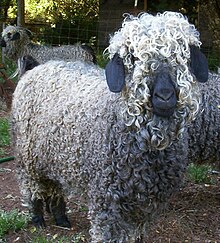This article needs additional citations for verification. (October 2024) |


Mohair (pronounced /ˈmoʊhɛər/) originated from the Arabic word [مهير] and it is a fabric or yarn made from the hair of the Angora goat (not Angora wool from the fur of the Angora rabbit). Both durable and resilient, mohair is lustrous with high sheen,[1] and is often blended to add these qualities to a textile. Mohair takes dye exceptionally well. It feels warm in winter due to excellent insulating properties, while moisture-wicking keeps it cool in summer. It is durable, naturally elastic, flame-resistant and crease-resistant. It is considered a luxury fiber, like cashmere, alpaca, angora, and silk, but is more expensive than most sheep's wool.
Mohair is composed mostly of keratin, a protein in the hair, wool, horns and skin of all mammals, but mohair's special properties are unique to the Angora goat. While it has scales like wool, they are not fully developed,[1] thus, mohair feels different from common or standard wool.
Mohair fiber is approximately 25–45 micrometres in diameter.[2] It expands in diameter with the age of the goat, growing along with the animal. Finer, softer hair from younger animals is used (for example) in scarves and shawls; the thicker, coarser hair from older animals is more often used for carpets and in heavy fabrics intended for outerwear.
The term mohair is sometimes used to describe the material in the folding roof on convertible cars. In this case mohair refers to a denim-like canvas.[citation needed]
- ^ a b Cite error: The named reference
1911EBwas invoked but never defined (see the help page). - ^ Williams, Beula (17 April 2007). "Llama Fiber". International Llama Association.